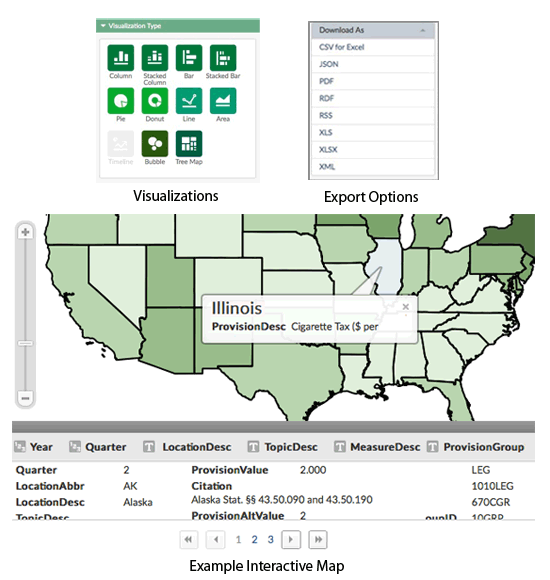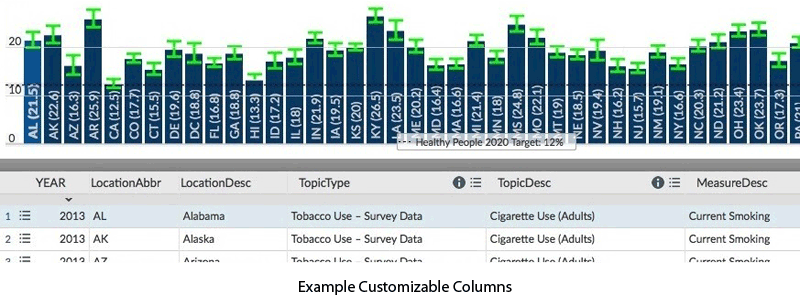Improving Access to Chronic Disease Data
 Interested in chronic disease data, risk factors, health indicators, and policy measures? CDC is making all these data and indicators much easier to access and use. Use the data to describe the burden of chronic disease as well as common risk factors, identify research gaps, monitor population trends, and evaluate programs.
Interested in chronic disease data, risk factors, health indicators, and policy measures? CDC is making all these data and indicators much easier to access and use. Use the data to describe the burden of chronic disease as well as common risk factors, identify research gaps, monitor population trends, and evaluate programs.
Chronic disease data and health indicators are widely used by researchers, scientists, students, health communicators, health educators, policy-makers, epidemiologists, state and local health departments, and many more. Since the recent launch of CDC's National Center for Chronic Disease Prevention and Health Promotion (NCCDPHP) new open data portal, there have been over 1.3 million views to 105 chronic disease data sets totaling over 33 million rows of data. The drive to bring this data together in one place with common tools was to make CDC's chronic disease data easier to access and use by both current and new audiences. In keeping with the Federal Government's Open Data Initiative, this initiative is intended to promote openness, interoperability, and innovation.
What are Open Data?
The underlying concept is actually quite simple. In many instances it's local, state and federal governments making all sorts of data openly available to the public to use, share or blend with other data to create such things as novel visualizations or apps.
Why Open Data?
The benefits of open data are many. By providing data in an open data format, we can
- Reduce time from data receipt to dissemination
- Speed access to self-service data
- Increase reach of public health data
- Foster data innovation
- Satisfy growing users' data demands – for example on mobile phones and tablets.
- Reduce need for ongoing major enhancements and custom development
- Increase data and application sharing, re-use and innovation
“Our data is used in so many ways to improve health across the country. By further enabling the openness and usability of our data, we hope to inspire creativity that results in health data application innovations that before now were unimaginable.” – Jason Bonander, Director, Office of Informatics and Information Resources Management, National Center for Chronic Disease Prevention and Health Promotion, Centers for Disease Control and Prevention.
Who is Doing Open Data?
Open data is about data for action and CDC's efforts are similar to those across the country in state and local governments, CDC partners, and many other organizations who put actionable data in the hands of communities. The goal is to go beyond open data and not just make it available but to help people tell better stories with data. Success stories show the importance of spending time with users and communities, understanding their data needs, and making data more accessible, usable, and useful for all sorts of user types.
- Centers for Medicare and Medicaid Services (CMS) unlocked health data and opened access to its digital archive previously only available to researchers
- Robert Wood Johnson Foundation is testing the usability and fitness of open health data for studying the relationship between childhood obesity and the built environment
- Chicago Department of Public Health opened their data and 30 mobile apps were built by others focused on target areas like safe bicycle routes, farmer's markets, etc.
- San Francisco, California, metro government published restaurant inspection data in an open, standardized format and then Yelp published it alongside its online restaurant reviews
- San Mateo County, California, aggregated community services, creating an open database of all local community organizations and the services they offered, and then created a centralized, searchable site called SMC-Connect
CDC Chronic Disease Data… Made Better
The National Center for Chronic Disease Prevention and Health Promotion's open data are available to help all make better-informed decisions on a wide variety of health topics.
New Features
- Customize maps and charts
- Filter views to group and summarize data
- Download data in all formats
- Interactive charts and maps allow change of labels, annotations, and other details
- Customize columns in tables and spreadsheets
- Create dashboards with flexible data views by charts or lists


Most of the health topics and Divisions in the National Center for Chronic Disease Prevention and Health Promotion are offering open data. Take a look at the Chronic Open Data website to explore the following.
More Information
- Page last reviewed: October 5, 2015
- Page last updated: October 5, 2015
- Content source:
Error processing SSI file


 ShareCompartir
ShareCompartir